高中英语试卷评讲课教学设计知识分享
高中英语试卷讲评教案
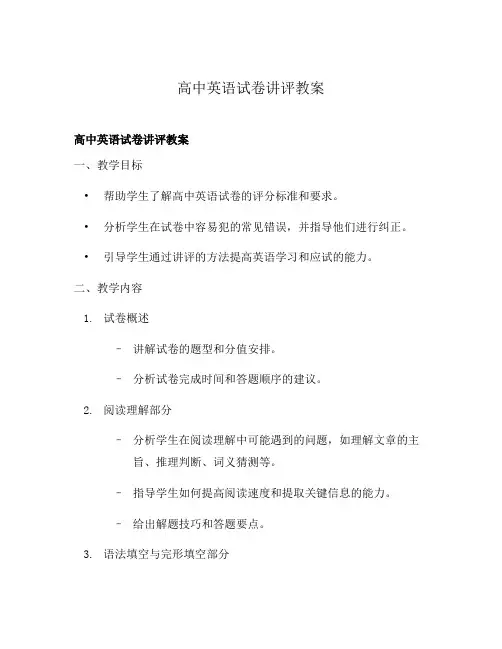
高中英语试卷讲评教案高中英语试卷讲评教案一、教学目标•帮助学生了解高中英语试卷的评分标准和要求。
•分析学生在试卷中容易犯的常见错误,并指导他们进行纠正。
•引导学生通过讲评的方法提高英语学习和应试的能力。
二、教学内容1.试卷概述–讲解试卷的题型和分值安排。
–分析试卷完成时间和答题顺序的建议。
2.阅读理解部分–分析学生在阅读理解中可能遇到的问题,如理解文章的主旨、推理判断、词义猜测等。
–指导学生如何提高阅读速度和提取关键信息的能力。
–给出解题技巧和答题要点。
3.语法填空与完形填空部分–指导学生掌握常见的语法知识和词汇用法。
–分析学生容易犯的常见错误,如动词时态、主谓一致、词形变化等。
–引导学生通过语境判断、选项排除等方法解题。
4.短文改错部分–分析学生在短文改错中容易犯的错误类型,如语法错误、拼写错误、词汇用法错误等。
–提醒学生注意标点符号、大小写、时态等方面的错误。
–解释评分标准和扣分要点。
5.书面表达部分–分析学生在书面表达中可能存在的问题,如句子结构、用词准确性、逻辑连贯性等。
–给出写作技巧和范文参考,指导学生如何提高写作水平。
–讲解评分标准和常见的扣分项。
三、教学方法•讲解分析法:通过解析试卷题目的设计和解题思路,引导学生理解题意和解题技巧。
•互动提问法:通过提问学生容易出错的地方,帮助他们准确理解知识点和答题要求。
•案例分析法:选取一些学生的试卷进行分析和评讲,让学生从错误中学习和充分认识标准答案的要求。
四、教学步骤1.介绍教学目标和教学内容。
2.带领学生回顾试卷的题型和分值安排。
3.以阅读理解部分为例,进行示范讲解,引导学生理解解题思路和答题要求。
4.分组活动:学生分组讨论并分析其他题型中的常见错误和解题技巧。
5.案例分析:随机选取几份试卷进行评讲,引导学生理解评分标准和答题要点。
6.解答学生的疑问,针对性提出改进建议和学习方法。
7.总结教学要点和方法,鼓励学生通过反思总结来提高应试能力。
高考英语试卷讲评的教案
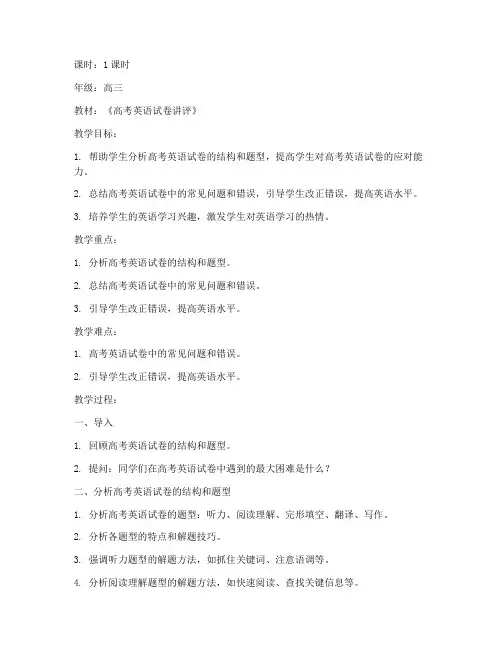
课时:1课时年级:高三教材:《高考英语试卷讲评》教学目标:1. 帮助学生分析高考英语试卷的结构和题型,提高学生对高考英语试卷的应对能力。
2. 总结高考英语试卷中的常见问题和错误,引导学生改正错误,提高英语水平。
3. 培养学生的英语学习兴趣,激发学生对英语学习的热情。
教学重点:1. 分析高考英语试卷的结构和题型。
2. 总结高考英语试卷中的常见问题和错误。
3. 引导学生改正错误,提高英语水平。
教学难点:1. 高考英语试卷中的常见问题和错误。
2. 引导学生改正错误,提高英语水平。
教学过程:一、导入1. 回顾高考英语试卷的结构和题型。
2. 提问:同学们在高考英语试卷中遇到的最大困难是什么?二、分析高考英语试卷的结构和题型1. 分析高考英语试卷的题型:听力、阅读理解、完形填空、翻译、写作。
2. 分析各题型的特点和解题技巧。
3. 强调听力题型的解题方法,如抓住关键词、注意语调等。
4. 分析阅读理解题型的解题方法,如快速阅读、查找关键信息等。
5. 分析完形填空题型的解题方法,如根据上下文推测、排除法等。
6. 分析翻译题型的解题方法,如准确理解句意、注意语法和时态等。
7. 分析写作题型的解题方法,如审题、组织语言、注意格式等。
三、总结高考英语试卷中的常见问题和错误1. 分析学生在听力、阅读理解、完形填空、翻译、写作等方面存在的问题。
2. 引导学生总结自己的错误,并进行分析和改正。
3. 强调注意细节、理解题意、提高词汇量等方面的重要性。
四、学生互动1. 学生分组讨论,交流自己在高考英语试卷中的错误和心得体会。
2. 每组选派代表分享讨论结果,教师点评和总结。
五、课堂小结1. 总结本次讲评的重点内容。
2. 强调学生在今后的学习中要注意的问题和改进方向。
3. 鼓励学生树立信心,努力提高英语水平。
六、课后作业1. 完成一篇高考英语作文,注意审题、组织语言、注意格式等方面。
2. 复习本节课讲评的内容,巩固所学知识。
教学反思:本节课通过分析高考英语试卷的结构和题型,总结高考英语试卷中的常见问题和错误,引导学生改正错误,提高英语水平。
高中英语试卷讲评教案(一)
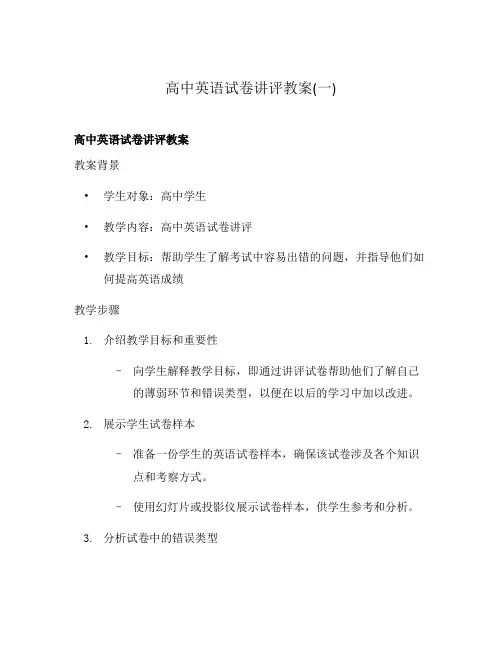
高中英语试卷讲评教案(一)高中英语试卷讲评教案教案背景•学生对象:高中学生•教学内容:高中英语试卷讲评•教学目标:帮助学生了解考试中容易出错的问题,并指导他们如何提高英语成绩教学步骤1.介绍教学目标和重要性–向学生解释教学目标,即通过讲评试卷帮助他们了解自己的薄弱环节和错误类型,以便在以后的学习中加以改进。
2.展示学生试卷样本–准备一份学生的英语试卷样本,确保该试卷涉及各个知识点和考察方式。
–使用幻灯片或投影仪展示试卷样本,供学生参考和分析。
3.分析试卷中的错误类型–按照试卷的顺序,列出学生常犯的错误类型。
例如,语法错误、拼写错误、翻译错误等。
–解释每种错误类型的特点,并提供示例以帮助学生理解错误的原因。
4.解释容易出错的题目–选取试卷中较为困难或容易出错的题目,逐一解释答案和解题思路。
–强调常见的误解和陷阱,并指导学生如何避免类似错误。
5.探讨提高英语成绩的方法–和学生一起讨论提高英语成绩的方法和技巧,如多做练习、积累词汇、注意语法和句型结构等。
–提醒学生制定学习计划并保持良好的学习习惯。
6.练习巩固–安排一些与试卷中相似的练习题,供学生随堂练习,以检验他们对讲评内容的理解和掌握情况。
教学效果评价•通过学生的参与和练习情况来评价教学效果。
•考察学生对讲评内容的理解和应用能力。
•了解学生对英语学习的态度和改进措施。
参考资料•教科书和教学参考资料中关于试卷讲评的相关内容高中英语试卷讲评教案(续)教学步骤(续)7.分组讨论和分享–将学生分成小组,让他们讨论并分享在试卷中容易出错的问题和解题困惑。
–鼓励学生在小组中互相解答问题和比较答案,促进彼此的学习和帮助。
8.提供解决问题的策略–在讨论和分享的过程中,引导学生提供解决问题的策略和技巧。
–提供一些建议,例如如何读懂题目、如何分析选项、如何有条理地写作等。
9.演示范例–选择一些典型的试题或写作题目,向学生演示如何正确解答。
–解释思考过程、技巧和方法,帮助学生理解和运用。
英语试卷讲评课教案
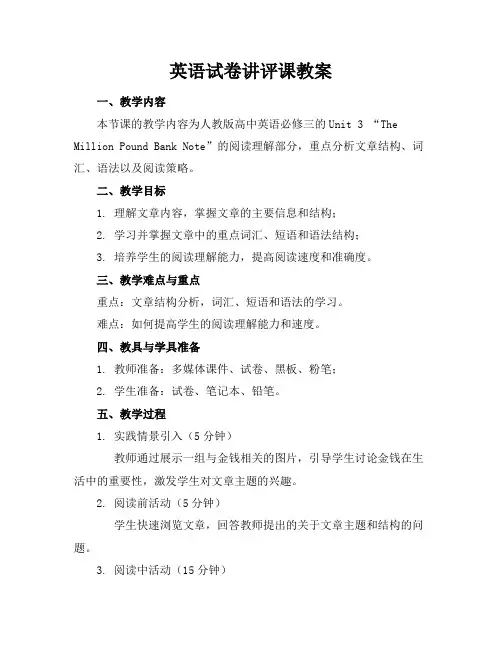
英语试卷讲评课教案一、教学内容本节课的教学内容为人教版高中英语必修三的Unit 3 “The Million Pound Bank Note”的阅读理解部分,重点分析文章结构、词汇、语法以及阅读策略。
二、教学目标1. 理解文章内容,掌握文章的主要信息和结构;2. 学习并掌握文章中的重点词汇、短语和语法结构;3. 培养学生的阅读理解能力,提高阅读速度和准确度。
三、教学难点与重点重点:文章结构分析,词汇、短语和语法的学习。
难点:如何提高学生的阅读理解能力和速度。
四、教具与学具准备1. 教师准备:多媒体课件、试卷、黑板、粉笔;2. 学生准备:试卷、笔记本、铅笔。
五、教学过程1. 实践情景引入(5分钟)教师通过展示一组与金钱相关的图片,引导学生讨论金钱在生活中的重要性,激发学生对文章主题的兴趣。
2. 阅读前活动(5分钟)学生快速浏览文章,回答教师提出的关于文章主题和结构的问题。
3. 阅读中活动(15分钟)学生精读文章,分析文章结构,学习词汇和语法。
教师讲解重点知识点,解答学生的疑问。
4. 例题讲解(10分钟)教师选取一篇类似的阅读理解文章,为学生讲解解题技巧,并进行示范解题。
5. 随堂练习(10分钟)学生独立完成一篇阅读理解练习,巩固所学知识。
6. 小组讨论(5分钟)学生分小组讨论阅读理解中的难题,分享解题心得。
六、板书设计1. 文章结构图;2. 重点词汇、短语和语法;3. 解题技巧。
七、作业设计1. 作业题目:完成一篇阅读理解练习;答案:见附件。
八、课后反思及拓展延伸1. 反思:教师针对本节课的教学效果进行自我反思,调整教学方法;2. 拓展延伸:推荐学生阅读与金钱相关的英文文章,提高阅读水平。
重点和难点解析1. 教学目标的设定;2. 教学难点与重点的确定;3. 教学过程中的实践情景引入、例题讲解和随堂练习;4. 板书设计;5. 作业设计;6. 课后反思及拓展延伸。
一、教学目标的设定1. 确保目标与教学内容紧密结合;2. 明确学生应掌握的知识和技能;3. 注重培养学生的实际运用能力。
高中英语试卷讲解教案
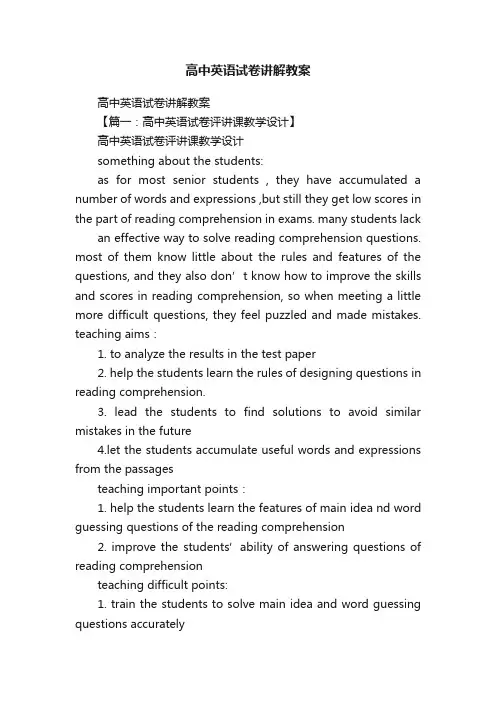
高中英语试卷讲解教案高中英语试卷讲解教案【篇一:高中英语试卷评讲课教学设计】高中英语试卷评讲课教学设计something about the students:as for most senior students , they have accumulated a number of words and expressions ,but still they get low scores in the part of reading comprehension in exams. many students lack an effective way to solve reading comprehension questions. most of them know little about the rules and features of the questions, and they also don’t know how to improve the skills and scores in reading comprehension, so when meeting a little more difficult questions, they feel puzzled and made mistakes. teaching aims:1. to analyze the results in the test paper2. help the students learn the rules of designing questions in reading comprehension.3. lead the students to find solutions to avoid similar mistakes in the future4.let the students accumulate useful words and expressions from the passagesteaching important points:1. help the students learn the features of main idea nd word guessing questions of the reading comprehension2. improve the students’ability of answering questions of reading comprehensionteaching difficult points:1. train the students to solve main idea and word guessing questions accurately2.train the students use rules to answer questions correctly。
高中英语试卷讲评教案5篇2022

高中英语试卷讲评教案5篇2022编写教案的繁简,一般是有经验的教师写得简略些,而新教师写得详细些。
原定教案,在上课进程中可根据具体情况做适当的必要的调整,课后随时记录教学效果,进行简要的自我分析,有助于积累教学经验,不断提高教学质量。
以下是小编带来的高中英语试卷讲评教案内容,感谢您的阅读,希望能帮助到您!高中英语试卷讲评教案1一、单元考点提示1.单词willing ,devote,cure,disadvantage,shock,institute,admire,deb t,expedition,merchant, exist,chart,botany,disaster,crew.2.短语devote…to 把……用在;把……献给succeed in (干)……成功give off 发出(光、热等)in honour of 为了纪念……;为向……表示敬意above all 首先;首要set off 使爆炸;引起;出发pay off 偿清(欠款等)at sea 在大海上;在航海take…by surprise 使……吃惊;出奇兵攻占in charge of 主管;负责set out 出发;开始in search of 寻找3.句型(1)I’m (not)sure… I’m not sure whether/if…(2)I doubt if/whether…(3)Making a map of the east coast was an important job.(4)The men often fall ill and suffer fever.(5)They will provide us with eggs and meat.4.交际英语(1)I doubt if he’ll be asked to speak again next year.(2)Perhaps I’ll go to that one.(3)Maybe it was useful for some people.(4)How did you find the talk this morning?(5)I shall insist on leaving at 7 a.m.sharp.(6)We’ve decided to do sth./that…(7)Have you decided which boat to take?(8)I suggest doing sth.二、考点精析与拓展1.have something(nothing,much,little)to do with与……有(没有,有很大,有一点)关系。
高考英语试卷讲评教案
课时:1课时教学目标:1. 通过对高考英语试卷的讲评,帮助学生了解高考英语的题型和考查内容,提高学生对高考英语的认识。
2. 通过讲评,让学生了解自己的优势和不足,明确复习方向,提高备考效果。
3. 培养学生良好的解题习惯,提高学生的英语应用能力。
教学重点:1. 分析高考英语试卷的题型和考查内容。
2. 对学生答题过程中出现的问题进行总结和讲解。
教学难点:1. 如何提高学生的英语应用能力。
2. 如何针对学生的不足进行有针对性的复习。
教学过程:一、导入1. 引导学生回顾高考英语试卷的结构和题型。
2. 提问:大家在答题过程中遇到了哪些问题?如何解决?二、讲评试卷1. 分析选择题:a. 分析完形填空、阅读理解、语法填空等题型的考查点和解题技巧。
b. 对学生答题过程中出现的问题进行总结,如:对词汇掌握不牢固、语法运用不当等。
c. 针对问题进行讲解和示范。
2. 分析非选择题:a. 分析作文、翻译等题型的考查点和解题技巧。
b. 对学生答题过程中出现的问题进行总结,如:语言表达不流畅、句式单一等。
c. 针对问题进行讲解和示范。
三、总结与反思1. 让学生总结自己在高考英语试卷中的优点和不足。
2. 引导学生针对自己的不足进行有针对性的复习。
3. 强调良好解题习惯的重要性,鼓励学生在备考过程中养成良好的解题习惯。
四、布置作业1. 针对试卷中的错题进行复习,加深对知识点的理解。
2. 完成一篇英语作文,提高自己的写作能力。
教学反思:本节课通过讲评高考英语试卷,让学生了解高考英语的题型和考查内容,提高了学生对高考英语的认识。
在讲评过程中,针对学生答题过程中出现的问题进行了总结和讲解,帮助学生找到自己的不足,明确复习方向。
同时,通过强调良好解题习惯的重要性,培养学生的英语应用能力。
在今后的教学中,我将进一步关注学生的个体差异,针对不同学生的特点进行有针对性的辅导,提高学生的英语水平。
高中英语试卷讲评课教案范文优秀
高中英语试卷讲评课教案范文优秀一、教学内容本节课选自高中英语教材第二册第九单元“Healthy Eating”,具体内容包括教材第九章“Reading and Writing: Evaluating an Argument”以及第十章“Workbook: Review of Units 79”。
详细内容主要围绕如何评估一个论点,分析健康饮食的重要性,并结合试卷讲评,针对学生在单元测试中出现的常见错误进行深入讲解。
二、教学目标1. 让学生掌握如何评估一个论点,提高学生的批判性思维能力。
2. 帮助学生巩固和运用所学词汇、语法知识,提高学生的英语综合运用能力。
3. 培养学生的团队合作意识,提高学生的课堂参与度。
三、教学难点与重点教学难点:如何引导学生正确评估论点,运用所学知识进行论证。
教学重点:对试卷中出现的常见错误进行分析、讲解,帮助学生巩固知识点。
四、教具与学具准备教具:多媒体教学设备、试卷、黑板、粉笔学具:试卷、笔记本、文具五、教学过程1. 导入(5分钟)实践情景引入:邀请学生分享自己在家制作健康饮食的经历,激发学生对本节课的兴趣。
2. 试卷讲评(15分钟)(2)针对试卷中的重点、难点进行详细讲解,帮助学生纠正错误。
3. 例题讲解(15分钟)(1)选取具有代表性的例题进行讲解,引导学生正确评估论点。
(2)结合教材内容,讲解相关词汇、语法知识。
4. 随堂练习(10分钟)(1)布置相关练习题,巩固所学知识。
(2)邀请学生上台展示,鼓励学生积极参与。
5. 小组讨论(10分钟)(1)将学生分成小组,针对某一健康饮食话题进行讨论。
(2)引导学生运用所学知识进行论证,提高学生的批判性思维能力。
六、板书设计1. 试卷讲评部分:列出重点、难点,标注易错点。
3. 随堂练习部分:列出练习题目,展示答案。
七、作业设计1. 作业题目:(1)完成Workbook中的Review of Units 79练习。
(2)针对某一健康饮食话题,写一篇小论文,评估论点并给出自己的观点。
【教案】高中英语试卷讲评教案
【教案】高中英语试卷讲评教案一、教学目标:1. 帮助学生理解试卷中的知识点,巩固所学知识。
2. 提高学生分析问题、解决问题的能力。
3. 培养学生的批判性思维和团队合作精神。
二、教学内容:1. 试卷分析:对试卷的整体难度、题型、分值等进行分析,让学生了解试卷的构成。
2. 错误分析:针对学生普遍存在的问题进行分类整理,找出错误的原因。
3. 知识点讲解:针对试卷中的重点、难点进行讲解,巩固学生的基础知识。
4. 解题技巧分享:分享解题技巧,帮助学生提高答题速度和准确性。
三、教学过程:1. 课前准备:教师提前准备好试卷分析报告,了解学生的答题情况。
2. 课堂导入:简要介绍试卷分析报告,激发学生的学习兴趣。
3. 试卷分析:教师引导学生对试卷进行分析,让学生了解试卷的难度和题型。
4. 错误分析:教师引导学生找出自己的错误,分析错误的原因。
5. 知识点讲解:针对学生的错误和疑问,教师进行详细讲解。
6. 解题技巧分享:教师分享解题技巧,引导学生进行讨论。
7. 课堂练习:学生进行课堂练习,巩固所学知识。
四、教学评价:1. 学生课堂参与度:观察学生在课堂上的发言和讨论情况,了解学生的学习积极性。
2. 学生练习成果:检查学生的课堂练习,评估学生的学习效果。
3. 学生反馈:收集学生的反馈意见,了解学生的学习需求。
五、教学资源:1. 试卷分析报告:教师自备。
2. 教学PPT:教师根据教学内容制作。
3. 课堂练习题:教师根据知识点设计。
4. 参考资料:教师提供相关参考资料,帮助学生巩固知识。
六、教学策略:1. 案例分析:通过具体案例,让学生了解试卷中的实际应用。
2. 小组讨论:引导学生进行小组讨论,培养学生的团队合作精神。
3. 互动提问:教师提问,学生回答,激发学生的思维活跃度。
4. 任务驱动:布置相关任务,让学生在实践中运用所学知识。
七、教学注意事项:1. 关注学生的个体差异,因材施教。
2. 鼓励学生提问,充分调动学生的积极性。
高中英语《高三英语试卷讲评课》优质课教案、教学设计
高中英语《高三英语试卷讲评课》优质课教案、教学设计1000字一、教学背景分析:高三英语试卷讲评课是一堂针对高三学生进行课堂辅导的课程,旨在对高三学生的英语水平进行与试题相匹配的精准辅导。
本节课程具体内容为课堂试卷答案的讲解和讲评,旨在让学生更加熟悉近期的考试内容和方法,加强对英语知识点的理解和掌握能力,帮助学生提高英语成绩。
本堂课共计45分钟,适用于高三上学期,英语科目的课堂辅导和试卷评讲教师。
二、教学目标:1.帮助学生全面了解近期英语考试的试题类型、难点和解题方法。
2.让学生认识自己在英语考试中的优势和不足。
3.让学生掌握英语学习中的关键方法,提高学生英语听、说、读、写及其综合能力。
三、教学过程:Step 1. 试卷整体评讲教师拿出英语试卷,直接进行整体评讲。
在展示试卷的同时,教师首先需要强调试卷中涵盖的知识点和试题类型,以便学生对试卷的整体框架有一个清晰的认识。
Step 2. 逐题型评讲教师逐一解释试卷中各类型的试题,包括阅读理解、短文改错、完形填空等。
此时,教师需要详细解读每道题目的考察目的、解题步骤和解题思路,以便学生更好地理解并掌握英语试卷的解题方法和技巧。
Step 3. 错误解析在整体讲解完试卷的各题型以后,教师开始对学生在考试中出现的错误进行解析。
在解析错误时,教师应该特别注重分析错误的成因,并提供相应的解决方案和改进方法。
Step 4. 学生讨论在评讲过后,教师应该充分利用课堂时间,让学生提出自己对试卷的疑惑、问题和建议,并与整个班级进行讨论和交流。
在学生讨论过后,可以让学生自主进行一些英语试题的练习,以检验学生的英语水平和掌握情况。
四、教学方法:1.讲解法:通过课堂试卷的解析进行教学。
2.研讨法:让学生在课堂上互相讨论,加深对英语知识点的理解。
3.引导法:通过教师的引导,让学生自主探究解决问题的方法。
五、教学评价:本节课程的评价主要从以下三个方面进行:1.学生对本节课程的反映和反馈:通过听取学生的反馈和意见,评估本节课程的效果和授课质量。
- 1、下载文档前请自行甄别文档内容的完整性,平台不提供额外的编辑、内容补充、找答案等附加服务。
- 2、"仅部分预览"的文档,不可在线预览部分如存在完整性等问题,可反馈申请退款(可完整预览的文档不适用该条件!)。
- 3、如文档侵犯您的权益,请联系客服反馈,我们会尽快为您处理(人工客服工作时间:9:00-18:30)。
高中英语试卷评讲课教学设计Something about the students:As for most senior students , they have accumulated a number of words and expressions ,but still they get low scores in the part of reading comprehension in exams. Many students lack an effective way to solve reading comprehension questions. Most of them know little about the rules and features of the questions, and they also don’t know how to improve the skills and scores in reading comprehension, so when meeting a little more difficult questions, they feel puzzled and made mistakes. Teaching aims:1. To analyze the results in the test paper2. Help the students learn the rules of designing questions in reading comprehension.3. Lead the students to find solutions to avoid similar mistakes in the future4.Let the students accumulate useful words and expressions from the passagesTeaching important points:1.Help the students learn the features of main idea nd word guessingquestions of the reading comprehension2.Improve the students’ability of answering questions of readingcomprehensionTeaching difficult points:1. Train the students to solve main idea and word guessing questions accurately2.Train the students use rules to answer questions correctly。
Teaching strategies :1. Work in groups to solve questions2. Different examples to consolidate what has been learned.procedure:Process Teacher’sactivitiesStudent’sactivitiesPurposesTimeplannedStep 1 Preparation (analyze the results of the test)Analyze theresults in the testpaper and praisethe students whodid wellMake aself-analysisLet the studentsknow their mainproblems andencourage thestudents who didwell3minsStep 2 Discussion Ask the studentsdiscuss mainideaquestions36,47Discuss main ideaquestions36,47.ingroupsGuide the studentsto think of the rulesand conclude themethods to solvesuch questions3minsStep3 Presentation 1. Ask thestudents toexplain how theychoose the bestanswer.2. Present thesteps of doingthe twoquestions3. conclude themethods1. Explain thereasons ofchoosing the bestanswer2.Talk about theirusual ways ofdoing main ideaquestions3.learn more waysLet students knowand master the stepsof doing main ideaquestions5minsStep 4 Practice 1. Ask thestudents to skipthe passage toget the topicsentence.2. Ask thestudents to tellthe methodsused in thequestions.1. Skip thepassage to get thetopic sentence2.Train thestudents to use themethods to solvethe main ideaquestionsConsolidate thesteps of doing mainidea questions5minsStep 5 Check answers 1. Guide thestudents todiscuss in groupsabout theanswers.2. Ask somestudents topresent theiranswers andexplain thereasons.3. Collect thestudents’problems andhelp themwhenevernecessary.1. Discuss ingroups about theirchoices.2. Some studentspresent theiranswers andreasons, while theothers listen andthink.3. Think about theskills they usedwhile doing thereading questions1.Improve theirconfidence bycooperating withothers2. Train thestudents’ ability tosummarize the skillsthemselves3minsStep6 Discussion Ask the studentsdiscuss mainideaquestions35,39,45Discuss main ideaquestions35,39,45.in groupsGuide the studentsto think of the rulesand conclude themethods to solvesuch questions3minsStep7 Presentation 1. Ask thestudents toexplain how theychoose the bestanswer.2. Present thesteps of doingthe threequestions3.conclude themethods1. Explain thereasons ofchoosing the bestanswer2.Talk about theirusual ways3.Learn morewaysLet students knowand master the stepsof doing wordguessing questions3minsStep 8 Practice 1. Ask thestudents to skipthe passage toguess themeaning of theunderlinedwords2. check theanswers .e the methodslearned to get themeaning of a wordConsolidate thesteps of doing wordguessing questions5minsStep 9 Check answers 1. Guide thestudents todiscuss in groupsabout theanswers.2. Ask somestudents topresent theiranswers andexplain thereasons.3. Collect thestudents’problems andhelp themwhenevernecessary.4.Askthe students totell the methodsused.1. Discuss ingroups about theirchoices.2. Some studentspresent theiranswers andreasons, while theothers listen andthink.3. Think about theskills they usedwhile doingreading questions1.Improve theirconfidence bycooperating withothers2. Train thestudents’ ability tosummarize the skillsthemselves5minsStep10 Words accumulatio n Make a list ofthe usefulexpressions andask the studentsto give theChinesemeanings bymeans ofdictionaries1.Give theChinesemeanings bymeans ofdictionaries2.Read theexpressions.Enlarge the studentsvocabulary 3minsStep11 Homework AssignhomeworkKnow what theyneed to do afterclassConsolidate whatthey have learned inclass1 min板书设计:Correct answers Students answers Group work课后反思:这堂课内容较多,一堂课处理起来较难,应做一些删减。
